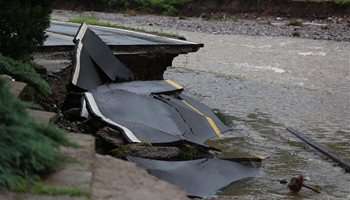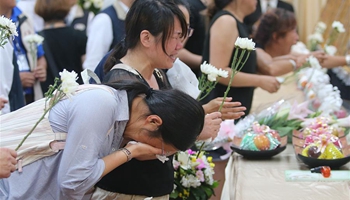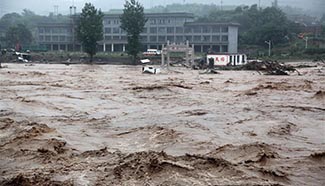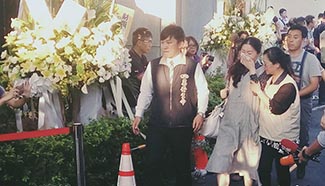ISLAMABAD/NEW YORK, July 22 (Xinhua) -- The United States has recently issued its first report on the civilian casualties of the strikes by the Unmanned Aerial Vehicles (UAVs), which, however, has aroused immediate suspicion and strong criticism from home and abroad.
The White House said earlier this month that between 64 and 116 civilians were killed in 473 U.S. strikes between 2009 and 2015 in Pakistan, Libya, Yemen, Somalia and North Africa, where the United States is not at war.
Civilian casualties in Afghanistan, Iraq and Syria were not included in the report, the first U.S. public assessment of its kind in the counterterrorism campaign.
SUSPICIOUS DATA
The released numbers have been widely attacked for being far too low to be accurate.
"A lot of these places are remote, hard to count, and there's a big issue of what do you count as a combatant; a lot of times they have a tendency to count someone as a combatant when they are not, and these numbers are very far off from third parties," said Paul Kawika Martin, a director with Peace Action, the largest U.S. grassroots peace network.
The London-based Bureau of Investigative Journalism, which provided a complete set of data on all known U.S. drone attacks in Pakistan, Somalia and Yemen, said the strikes have killed between 424 and 966 civilians, including about 200 children. According to its calculation, U.S. drones have caused 492 to 1,100 civilian deaths in Pakistan and other countries since 2002.
"But the trouble is far too often, we do not know who has been killed by drones, so we don't know if they're an innocent civilian in the wrong place at the wrong time," Jack Serle, a reporter for the Bureau, told Xinhua.
Saeed Chaudhary, director of the Independent Bureau for Humanitarian Issues in Islamabad, said that the drone report from the U.S. government is "sheer nonsense," adding that the U.S. drone campaign has killed more than 3,000 innocent civilians and handicapped hundreds.
Shahzad Akbar, a lawyer, is leading the legal battle for the civilians killed in the U.S. drone strikes in Pakistan's tribal regions.
In October 2006, many civilians, including nearly 80 children, were killed in a U.S. drone strike on a religious school in the Bajaur tribal area, Akbar said. Some 60 people lost their lives when drones rained missiles down on a funeral in South Waziristan in June 2009.
In March 2011, 40 people were killed when U.S. missiles struck a "Jirga" or assembly of tribal elders in North Waziristan, Akbar said.
"There are a lot of similar incidents," said Akbar, noting that the above-mentioned ones are just three well-documented cases among numerous tragedies in which civilians were hit by U.S. drone strikes in Pakistan.
LACK OF TRANSPARENCY
Apart from the erroneous report, the United States has mostly been covert about its drone campaigns.
"We don't know actually what the exact formula is when they make a decision for drone strikes. But they do know that there are civilians there," said Martin.
"And, typically there may be a rule of thumb that it's okay to kill five civilians, if we get the one high-level target. So, sometimes we do know that they are there, and we are killing them on purpose," Martin added.
Actually, the United States claims that if confronted with imminent dangers, it can launch drone strikes against any targets in the absence of clear evidence, the American Broadcasting Corporation quoted a document about the instructions on the use of drones from the Obama government as saying.
But if there was no clear evidence, how could the U.S. decision-makers define imminent dangers?
Rosa Brooks, a former legal adviser at the Pentagon and now a law professor with Georgetown University, said at a Congress hearing that the sitting U.S. executive departments proclaim that they are entitled to drone striking anyone in any corner of the world just on the grounds of confidentiality. Moreover, the decision to carry out drone strikes could be made by officials who demand anonymity and through secret procedures. All these, she said, were terrifying.
UNJUSTIFIABLE
The drone war, initiated in the wake of the 9/11 terrorist attack by then U.S. President George W. Bush, has often been used by the incumbent President Barack Obama in his two terms as one of his government's trump cards.
But the questions are: How can the drones tell the civilians from the terrorists, and are the drone strikes justifiable?
Abdul Karim Khan, a native of Mirali in North Waziristan in Pakistan, lost his son Zahinullah and brother Asif Iqbal to a December 2009 Central Intelligence Agency (CIA) drone strike. Both of Khan's family members had died while sitting at home.
"The American leader has in fact used armed drones for assassinations," said Akbar.
On July 2, Pakistan demanded an immediate cessation of U.S. drone strikes in its territory, terming them a violation of "territorial integrity and sovereignty of states."
American citizens have also fallen victim to the drones. Anwar al-Awlaki, a U.S.-born Al-Qaida in the Arabian Peninsula (AQAP) leader, was killed in a U.S. drone strike in 2011. His 16-year-old son, a U.S. citizen with no links to terrorist groups, was also killed in the attack.
Even those taking part in the U.S. drone program have raised concerns about the U.S. drone policies.
It's reported that last November, four former American drone operators held a press conference in New York, saying the strikes had caused the deaths of a large number of civilians and had cultivated a hardened institutional culture toward the victimized children and adults.
Using drones to murder innocent civilians is intensifying terrorism. The drones might kill four terrorists, only to create 10 more, former Staff Sergeant Brandon Bryant, one of the operators, was quoted as saying.










